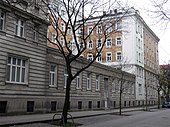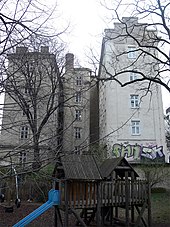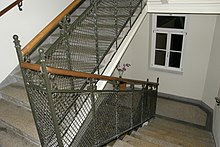Meldemannstrasse men's dormitory
The men's dormitory at Meldemannstrasse 27 (originally: 25–29, then: 25–27, last 2003: 25) was a homeless shelter in Vienna in the 20th district of Brigittenau from 1905 to 2003 . It became known as the place of residence of Adolf Hitler between 1910 and 1913.
The men's home until 1922
At the end of September 1904, the official building permit was issued for the construction of the men's lodging house and the foundation work began. The lodging house, which was to offer an exemplary home for 544 men on four floors in 24 halls for cheap payment , was built according to the London Rowton House system : separate sleeping compartments, common day rooms. The new building was based on the award-winning designs by the Austrian architects Leopold Ramsauer (1874–1916) and Otto Richter (1875–1919).
The six-story men's home was one of the most modern in Europe when it opened on October 15, 1905, without any festivities. It was financed by the Kaiser Franz Joseph I Anniversary Foundation for People's Housing and Welfare Institutions , a fund supported by private donations . Emperor Franz Joseph I paid a visit to the institution, which was the foundation's second largest up to that point, on November 7, 1905. The building was administered by the City of Vienna, and the management was in the hands of an administrator who lived in the building himself.
One of the first goals of the new men's home was to reduce the number of bed-goers , which in 1910 was 80,000 in Vienna. As early as mid-1909, the anniversary foundation had to determine that the men's home had reached the limit of its capabilities.
The house had gas lighting and, for added convenience, electric light bulbs . It was heated with a modern low-pressure steam heater .
On the ground floor were the dining room, a reading room with daily newspapers and a smoking and non-smoking section and a library that could be used from October 1, 1910. In the basement there was a clothes and shoe shine room, a luggage room, a bicycle cellar and a shoemaker's and tailor's workshop. There was a sick room with a family doctor and a disinfection chamber for delousing the newcomers. In addition to washrooms and shaving rooms, the residents were offered a bathing facility with 16 showers and 4 tubs.
For self-caterers there were kitchenettes with gas stoves and dishes.
The sleeping area was on the top four floors. It was opened at 8 p.m. and had to be evacuated around 9 a.m. Instead of a mass dormitory, the home had individual cabins for each of the 544 guests. The individual sleeping compartments were 1.4 meters wide and 2.17 meters long. In it stood a bed, a table, a clothes rack and a mirror. Each bunk had a lockable door and, as a special luxury, a light bulb.
The rent was 2.50 kroner per week and was based on the average rent that a bed-walker in Vienna had to pay for a place to sleep at that time. For a single unskilled worker or skilled tradesman with an annual income of 1,000 kroner, the men's home was an extremely cheap place to stay. Accordingly, it was praised in the press as a "fairy tale of heavenly accommodation on earth" and as a "miracle of elegance and cheapness".
During the war the home was used as a hospital for wounded soldiers, after November 12, 1918 as a civilian hospital. From November 1919 the house was empty. In 1922, with an estimate of 20 million kroner, the home was acquired by the municipality of Vienna and converted into a care house for around 500 male foster care.
In 1941, based on the renaming of the city hospitals, the Meldemannstrasse supply house was given the name Wiener Stadt Altenheim Zwischenbrücken . From the end of 1945, part of the old people's home was run as a municipal hostel for the homeless (men's hostel) .
Adolf Hitler in the men's dormitory
Adolf Hitler (1889–1945), allegedly at least since autumn 1909 in the hostel in Vienna-Meidling built by the Asylum Association for the homeless , lived in this men's home for three years, according to the police register from February 9, 1910 to May 24, 1913. Then he moved he to Munich .
In the mornings he read the newspapers regularly in the non-smoking section of the reading room. There he also painted his pictures, discussed political issues with the residents and gave speeches.
Various residents of the men's dormitory later wrote memories of their time with Hitler, namely the tramp and casual worker Reinhold Hanisch , whose report was published posthumously in 1939 by the American newspaper The New Republican , a man named Karl Honisch, who in 1938 wrote a report for the party archive of the NSDAP wrote down in Munich, the casual worker Josef Greiner , who presented thin memory books in 1938 and 1947, as well as a stranger known in research as "Brno Anonymus", whose memories appeared in a Czech newspaper in the 1930s. Other residents of the men's dormitory, with whom Hitler was at least temporarily in close contact during his stay, were the Jews Josef Löffner and Eduard Neumann, with whom Hitler was friends, the chemist Rudolf Häusler , with whom he emigrated to Germany in 1913, and the Painter Karl Leidenroth, whom Hitler viewed as his competitor and enemy.
closure
At the end of the 1990s, the Viennese city government decided to close the home due to the outdated structural design and to build a new home on Siemensstrasse in Vienna's 21st district .
After the opening of the Siemensstrasse building , the homeless shelter was closed on November 28, 2003, which resulted in a squatting . The new home in Siemensstrasse was officially opened on March 5, 2004.
In the last year of its existence as a men's hostel, the house at Meldemannstrasse ( OZ 25) offered 246 places for men, including overnight beds for men.
Theatrical location
Before it was closed from its premiere on September 24, 2002, the Meldemannstrasse men's dormitory was the setting for the theater production Mein Kampf by George Tabori with Alexander Waechter - Schlomo Herzl, Nicola Filippelli - Lobkowitz, Michael Smulik - Hitler; Directed by Tina Leisch and Hubert Kramar . Because of its great success, the piece was added to the repertoire on March 25, 2003 and performed twice a week until April 19, 2003. In the same year the production was awarded the Nestroy Theater Prize for best off-production.
Conversion to a nursing home
The former homeless shelter was converted into a nursing home with almost 200 rooms in 2007 . Because the historic building is a listed building, interventions on its facade were not permitted. During the renovation, the former garden-side window front was integrated into the house. The public use of the 9,000 m² park was considered.
The reopening of the building under the new name “Seniorenschlössl Brigittenau” took place on August 20, 2010. The entrance was moved from Meldemannstrasse to Winarskystrasse .
literature
- Max Winter : Berlin and Vienna asylum houses . From: Arbeiter-Zeitung of January 8, 1899. - Full text online .
- Menheim (Vienna XX. District, Meldemannstrasse No. 27) built by the Emperor Franz Joseph I. Jubilee Foundation for public housing and welfare institutions . Self-published by the foundation, Vienna 1905. ( ZDB -ID 1443746-6 ).
- “Men's home” in Vienna, XX. Meldemannstrasse 27. In: Wiener Bauindustrie-Zeitung , year 1906, pp. 169–173. (Online at ANNO ). .
- Leopold Ramsauer, Otto Richter: General building conditions and building description including addendum for the construction of a men's home and a family home. Possibly in place of the latter, men's home II. Part, on the property EZ 1916, ... and 1923 in the XVII. Viennese districts of Hernals, ... for public housing and welfare institutions in Vienna. Brakl, Vienna 1909.
- The supply institutions . In: Das neue Wien, Städtewerk . Volume II. Edited with the official cooperation of the municipality of Vienna, Elbemühl, Vienna 1927, p. 509 f. - online .
- Gerhard Roth: The Archives of Silence, Volume 7: A journey into the interior of Vienna, pages 89-109, “The Hitler Villa” . Fischer Taschenbuch Verlag, Frankfurt am Main 1993, ISBN 3-596-11407-1 .
- Katharina Rauscher: Several urban homeless shelters are being closed - one of them is still being used for theater. The last curtain in the men's home . In: wienerzeitung.at , September 9, 2002 and April 6, 2005, accessed on September 6, 2012.
- Brigitte Hamann : Hitler's Vienna. Apprenticeship as a dictator . Ninth edition. Piper, Munich 2007, ISBN 978-3-492-22653-0 .
- Franziska Leeb: Seniorenschlössl Brigittenau "Wie Daham". Gasparin & Meier - Vienna (A) - 2009 . In: nextroom.at , April 10, 2010, accessed on October 17, 2017.
Web links
-
In the "men's home". In: Reichspost , Morgenblatt, No. 156/1909 (16th year), June 8, 1909, p. 8 middle. (Online at ANNO ). .
- The men's home in Zwischenbrücken. In: Reichspost , Mittagsblatt, No. 159/1909 (XVIth year), June 11, 1909, p. 5 middle. (Online at ANNO ). .
- A model institute! The retirement home in the XX. District. In: Die Rote Fahne , No. 1688/1924 (Volume VII), November 28, 1924, p. 3. (Online at ANNO ). .
Individual evidence
- ↑ Local report. (...) Construction of a large men's lodge. In: Neue Freie Presse , Morgenblatt, No. 14409/1904, October 5, 1904, p. 8, bottom right. (Online at ANNO ). .
- ↑ Peter Pantucek: The Meldemannstrasse - A street name for a house . From: Hertha Hurnaus, Bernhard Kerbel, Peter Pantucek, Wolfgang Paterno (eds.): House Meldemannstrasse . Czernin, Vienna 2003, ISBN 3-7076-0167-6 . - Text online in: pantucek.com , accessed on September 6, 2012.
- ↑ Hamann: Hitler's Vienna , pp. 229–234.
- ↑ Visit of the emperor in the men's home and in the home for homeless families. In: Neue Freie Presse , Abendblatt, No. 14803/1905, November 7, 1905, p. 3 middle. (Online at ANNO ). .
- ↑ Little Chronicle. (...) Emperor Franz Josef I .- "Jubilee Foundation for People's Housing and Welfare Institutions". In: Neue Freie Presse , Morgenblatt, No. 16091/1909, June 9, 1909, p. 11, bottom center. (Online at ANNO ). .
- ^ Christian Stifter: "Library work is not philanthropy". On the historical role of the public libraries in the context of popular education in the 19th and 20th centuries . From: Alfred Pfoser , Peter Vodosek : On the history of public libraries in Austria . BVÖ materials, Volume 2. Austrian Library Association, Vienna 1995, ISBN 3-901639-01-2 , pp. 70-87. - text online . In: adulteducation.at , accessed on September 6, 2012.
- ↑ Daily report. (...) The empty men's home in the 20th district. In: Neues Wiener Abendblatt , No. 322/1920 (LIV. Volume), November 23, 1920, p. 2, column 2 middle. (Online at ANNO ). .
- ↑ The supply institutions .
- ↑ Viennese hospitals are named after great doctors. New names for the city hospitals. In: Neues Wiener Tagblatt , No. 140/1941 (LXXV. Volume), May 21, 1941, p. 5. (Online at ANNO ). .
- ↑ Felix Czeike ( inter alia): Homeless shelter in the Vienna History Wiki of the City of Vienna Homeless shelters after the Second World War , accessed on October 14, 2017.
- ↑ Anna Maria Sigmund : Did Hitler ever live in a homeless asylum? ( Memento of the original dated May 7, 2017 in the Internet Archive ) Info: The archive link was inserted automatically and has not yet been checked. Please check the original and archive link according to the instructions and then remove this notice. In: wienerzeitung.at , February 26, 2010, accessed on October 14, 2017.
- ↑ Hamann: Hitler's Vienna , pp. 227 and 568.
- ↑ Hamann: Hitler's Vienna , p. 237.
- ↑ Town hall correspondence of March 2, 2004
- ↑ Homes for the homeless . In: Handbuch der Stadt Wien , Volume 2003 (CXVII. Volume), Part II: Wien – Aktuell . Jugend und Volk, Vienna 2003, p. II / 169. - online .
- ↑ Resumed : "Mein Kampf". In the Meldemannstrasse, Tabori's farce is being played again “because of its great success” . In: derstandard.at , January 27, 2003, accessed on October 13, 2017.
- ↑ Wenzel Müller: Most famous men's dormitory in the world now a nursing home ( memento of the original from August 1, 2017 in the Internet Archive ) Info: The archive link was inserted automatically and has not yet been checked. Please check the original and archive link according to the instructions and then remove this notice. . In: springermedizin.at , May 12, 2010, accessed on October 13, 2017.
- ↑ Brigittenau. Senior citizen's castle instead of a homeless shelter. (...) Street name is changed . In. wiev1.orf.at , July 10, 2007, accessed on October 13, 2017.
- ↑ MA 53 (Red.): Wehsely / Derfler open the "wie daham ..." Seniorenschlössl Brigittenau . In: wien.gv.at , August 20, 2010, accessed on October 13, 2017.
Remarks
- ↑ Registered office : Vienna-Innere Stadt , Börsegasse 11 (in the building of the Vienna Stock Exchange ).
- ↑ The visit to the men's home was immediately followed by the first imperial inspection of the nearby home for homeless families . The Asylum, Vienna-Brigittenau , Universumstraße 62, of the privately founded association in 1899 was built according to the plans of Ernst Gotthilf (1865–1950) and opened on October 18, 1902 with a ceremonial laying of the keystone. - See: The keystone in the home for homeless families. In: Neue Freie Presse , Morgenblatt, No. 13705/1902, October 19, 1902, p. 12 middle. (Online at ANNO ). .
- ↑ During Hitler's time in the home, these were Johann Kanya and Robert Schaffer.
- ^ Until November 20, 1908: Blattgasse 4 and 6, Wien-Landstrasse , then Asylgasse 2 (today: Kastanienallee 2), Wien-Meidling .
Coordinates: 48 ° 14 ′ 21.6 ″ N , 16 ° 22 ′ 43.9 ″ E






